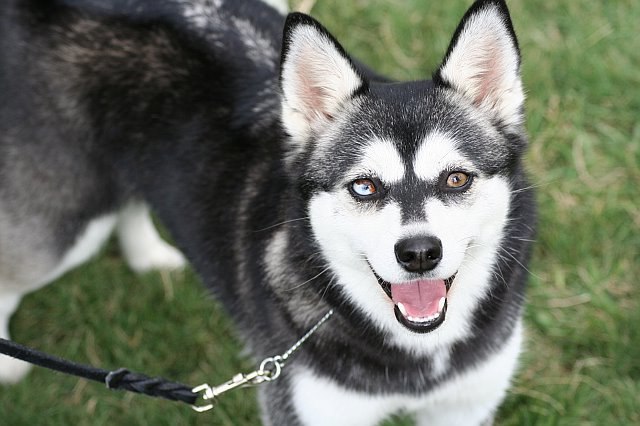


The Alaskan Klee Kai is a small to medium-sized breed that closely resembles the Siberian Husky but is much smaller in size. They were bred to be companion dogs with the striking appearance of a sled dog, known for their independent and intelligent nature. These dogs are known for their high energy levels, affectionate personality, and strong bond with their owners. Despite their small size, they are highly alert and protective, making them excellent watchdogs. They are also known for their beautiful, thick double coat, erect ears, and distinctive facial markings that resemble a miniature Husky.
The Alaskan Klee Kai was developed in the 1970s by Linda Spurlin in Alaska, USA. She wanted to create a small dog that resembled the Siberian Husky in both appearance and temperament, but was better suited to life as a companion dog. To achieve this, she selectively bred Huskies with smaller dogs, including the American Eskimo Dog and the Schipperke, which helped to create the breed’s distinct features. The name "Klee Kai" means "small dog" in Inuit, reflecting its compact size. The breed was officially recognized by the American Rare Breed Association (ARBA) in 1995 and later by the United Kennel Club (UKC) in 2011. Although relatively new, the Alaskan Klee Kai has gained popularity as a family pet and companion dog due to its striking looks and playful personality.
The Alaskan Klee Kai is a small to medium-sized dog with a compact, muscular build. The breed comes in three size variations: toy, miniature, and standard. The height ranges from 13 to 17 inches at the shoulder, with weights ranging from 10 to 20 pounds. They have a thick double coat that helps protect them from cold weather, much like the Siberian Husky, and their coat colors typically include black, gray, red, and white. Their facial markings are similar to those of the Husky, with distinctive masks and markings around the eyes, and their eyes can be blue, brown, or even one of each. The Alaskan Klee Kai's ears are triangular and stand erect, adding to its wolf-like appearance. Their tails are bushy and carried over the back in a slight curve, adding to their fox-like look.
The Alaskan Klee Kai is a highly intelligent and independent dog. They are known for their alertness, making them excellent watchdogs. While they can be reserved with strangers, they are affectionate and loyal to their families. They tend to bond closely with their owners and often form strong attachments. Despite their independent nature, they enjoy spending time with their human family and thrive in environments where they are involved in daily activities. The breed can be a bit shy or cautious around new people or situations, so early socialization is important to ensure they grow into well-adjusted adults. Alaskan Klee Kais can also be a bit vocal, often "talking" to express their feelings or alert their owners to something happening around them.
Although the Alaskan Klee Kai is small in size, they have high energy levels and require regular exercise. Daily walks, playtime, and opportunities for mental stimulation are essential to keep them happy and healthy. They enjoy activities that challenge them, such as puzzle toys or agility training. Their energetic nature makes them a good companion for active families who can provide them with sufficient outlets for their energy. Alaskan Klee Kais also have a strong prey drive, so they should be kept on a leash or in a securely fenced area when outdoors to prevent them from chasing after small animals. Despite their energetic nature, they are adaptable and can thrive in a variety of living situations, including apartments, as long as they get enough exercise and mental stimulation.
The Alaskan Klee Kai is an intelligent breed that learns quickly, but their independent and sometimes stubborn nature can make training a challenge. They respond well to positive reinforcement techniques, such as treats, praise, and play. Harsh training methods should be avoided, as they can be counterproductive and cause the dog to become more independent or even fearful. Early socialization is important to help the Alaskan Klee Kai become comfortable with new people, pets, and environments. Socialization should begin at a young age to ensure that they grow into well-behaved and confident adults. Consistent and patient training is key to managing their independent streak and ensuring they understand their boundaries.
The Alaskan Klee Kai is generally a healthy breed, but like all dogs, they can be prone to certain health issues. Some common health concerns for this breed include patellar luxation (a condition where the kneecap slips out of place), hip dysplasia, and some genetic eye conditions. Regular veterinary check-ups, a healthy diet, and appropriate exercise are important to maintain the health and well-being of the Alaskan Klee Kai. Grooming is also important to maintain their thick double coat, which sheds seasonally. Regular brushing, particularly during shedding periods, can help manage loose fur and keep their coat in good condition. Routine dental care, ear cleaning, and nail trimming should also be part of their grooming routine.
The typical lifespan of an Alaskan Klee Kai is around 12 to 16 years. With proper care, including a balanced diet, regular exercise, and routine veterinary visits, they can live a long and healthy life. As with all breeds, early detection of health issues and maintaining a healthy lifestyle are important factors in ensuring that they live a full life.
© copyright Dog Compendium 2024 - 2025